


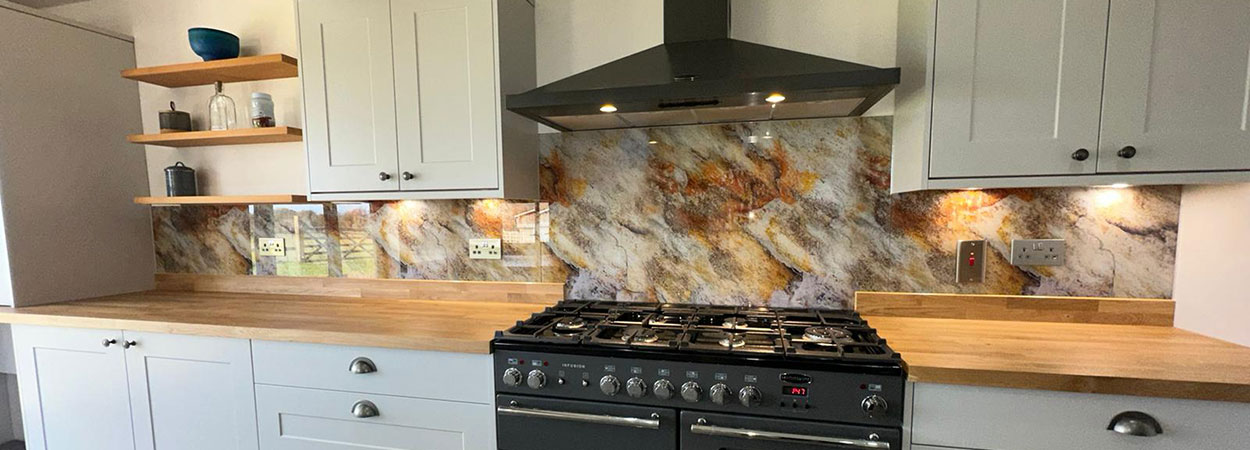




















Splashbacks of Distinction project - LED Backlit Splashback, Royston
LED back lights are becoming a very popular addition to so many homes. A trip to the shops or DIY stores will demonstrate just how popular they have become.
There are LED lights to light the rear of pictures, mirrors, even televisions. Some people are even fixing them behind their beds to illuminate their room at bedtime. LED lights are greener to run than old fashioned lighting alternatives, so whath2s not to love about them?
Long gone are the days when you needed halogen spotlights to illuminate your home. They are cumbersome and can cost a small fortune to run. The heat they generate can be quite intense too. LED backlit splashbacks can change all this in your Royston property.
How LED backlit glass splashbacks work
With an artistic design printed on the back of the glass very lightly, we are able to achieve the design without a light backing but also achieve illumination in various lights through the LED strips installed in a track behind the glass. With a colour wheel on the remote control for the LED Lights, the customer now has an unlimited choice of colours and brightness for their glass splashback.
The best part of this is that you will no longer have to rely on shining an actual light source at the splashback to achieve a great look. To have the beauty of your glass splashback brought to life by an in built backlit LED truly is a sight to behold. Your friends and visitors to your property will marvel at the beautiful changing array of colours, or you could choose to keep it at a single colour if you choose. Whatever you decide, an LED backlit splashback will add interest and beauty to a functional and hygienic toughened glass splashback.
Where is Royston?
Royston is a town in North Hertfordshire. Royston is situated on the Greenwich Meridian, which brushes the town's eastern boundary, and at the northernmost apex of the county on the same latitude as towns such as Milton Keynes and Ipswich. It is about forty three miles north of central London in a rural area.
Before the boundary changes of the 1890s, the boundary between Hertfordshire and Cambridgeshire ran east-west through the centre of Royston along the middle of Melbourn Street.
Some Royston history
Royston grew at the crossing of two ancient thoroughfares, Ermine Street and the Icknield Way; the former was created after the Roman conquest, while the Icknield Way has long been accepted as a prehistoric route way. The roads are sometimes called military roads as they were prepared or improved by Roman soldiers to facilitate access to the hinterland of Roman Britain. The path of Icknield Way is occupied by the present day A505, which bypasses Royston to the north. The A10 follows the alignment of Ermine Street south of Royston but diverts before it reaches the crossroads. The A1198, known as the Old North Road follows the alignment of Ermine Street northwards. Barrows on Goffers Knoll and Therfield Heath are evidence of prehistoric settlement.
A cross, variously known as Royse's, Rohesia's, or Roisia's Cross, was erected by the crossroads at an unknown date. It gave the settlement its earliest name of Crux Roesia or Roisia's Cross. By the 14th century this had become Roisia's Town, Roiston or Royston. A large boulder of red millstone grit, bearing a square socket, supposed to be the base of the cross, has been placed by the cross roads at the northern end of High Street.
Until 1540 Royston was divided between five parishes: Barkway, Reed and Therfield in Hertfordshire and Melbourn and Kneesworth in Cambridgeshire. In that year it became a separate ecclesiastical parish, partly in each county.
Ralph de Rochester founded the Augustinian priory which originated as a chapel for three canons and was later expanded to seven or more regular canons. Royston had two hospitals or free chapels, as well as the monastery.
The hospital of St John and St Thomas was founded for lepers in 1224 by Richard Argentine, Sheriff of Cambridgeshire on the south side of Baldock Street.
The hospital of St Nicholas was situated in the Cambridgeshire side of Royston. It was founded in about 1200 probably by Amphelise, a daughter of Richard the Chamberlain. In 1213 King John granted a fair to celebrate the feast of St Nicholas on the 8th and 9th May. The patronage of the hospital descended to Sir Giles Argentine, lord of the manor of Melbourn, who also held the patronage of the other hospital. In the 14th century, St Nicholas' Hospital was put under the same jurisdiction as that of St John and St Thomas, which were subsequently suppressed in 1547.
The town having lost its monastic charter, the priory site was obtained by Robert Chester, a gentleman of the bedchamber to King Henry VIII, who set up a market. Much of the town was given over to inns catering for travellers mainly travelling between London and York.
Royalty and Royston
On 29 April 1603 James VI and I, travelling to Westminster to be crowned as King of England, stayed overnight at the Chester residence. His grandmother Mary of Guise had stayed there in 1551. Attracted by the suitability of the area for hunting, James hired the house for a year. In 1604 he decided to create a royal hunting lodge in the town by demolishing the "Cock" and "Greyhound" inns. The king's lodgings were completed in 1607. The buildings were never big enough to cater for a full royal court, but provided a suitable spot for hunting, near enough to London for convenience and far enough away to deter intrusion. King James ordered a strict prohibition on anyone taking game from within sixteen miles of Royston, and an elaborate infrastructure was established to support him in the pursuit of his sport. He returned almost every year to hunt and shoot.
Queen Anne and Henry Frederick, Prince of Wales, visited the town once, in 1611-1612. The next year, the queen opposed the marriage of her daughter Princess Elizabeth to Frederick V, Elector Palatine, but the king came to Royston with the Earl of Rochester to negotiate the dowry, and a marriage contract was signed there. Following the marriage, celebrated on St Valentine's Day 1613, the king, Prince Charles, and Frederick came to stay at Royston.
James's successor, King Charles I, visited Royston less often than his father. In June 1647, during the English Civil Wars, Charles was brought through the town as a prisoner of the Parliamentary army. After Charles's execution, the royal buildings fell into disrepair. The Crown sold its last interests in the town in 1866.
Royston had its own bank
Royston had a local bank, called the Royston Bank, from about 1806 to 1896, when it merged into the grouping that became Barclays. It was founded by Edward King Fordham and others, and the business was run by the influential local Fordham family.
The Church of England parish church of St John the Baptist was severely damaged by a fire that broke out in the early morning of 9 December 2018, with the blaze destroying part of the roof and bell tower. Initially thought to be arson, a police investigation later concluded this not to be the case. The church was reopened in November 2022, almost four years after the fire, with an open day held on 26 November.
Brighten your life with an LED backlit glass splashback
If you live in or around Royston and would like something extra special to brighten up your glass splashback, we can help you achieve this. Splashbacks of Distinction have been making, supplying and fitting toughened glass splashbacks for many years. There is very little we don't know about how glass can transform any property.
Having an LED backlit splashback simply takes that transformation to new heights. Why not call us to discuss your requirements today?
Read about some of our other projects

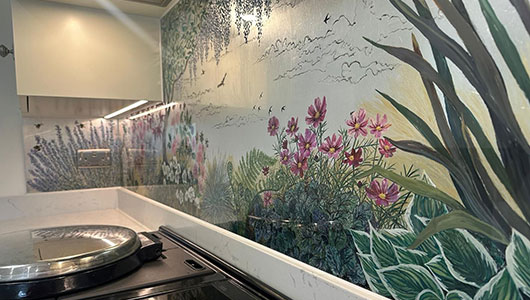




Kitchen Splashback in Hitchin by Artist Johanna Wood
We templated, supplied and installed the glass, and then the artist Johanna Wood painted the splashbacks. The result looks amazing with intricate details which create a bespoke design.

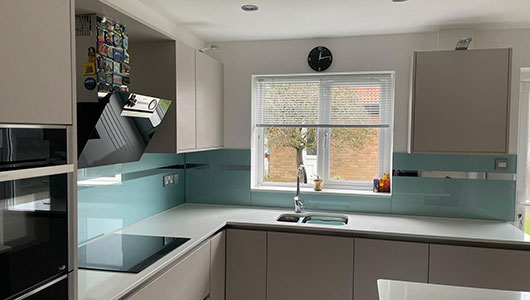


Kitchen Splashback with Mirror Line, Newmarket
This splashback was painted in Ellis Ikon Azure. We also added a mirrored line through the splashbacks which is quite popular. The customer can choose the position and quantity of the lines and also the thickness so can avoid sockets etc.
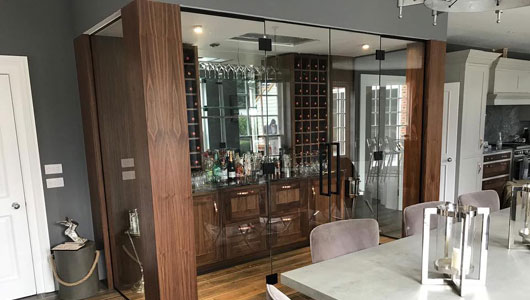
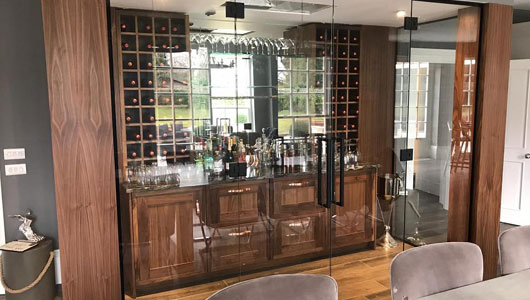



Wine Room, Roydon
Working alongside Brandt Kitchens we installed the glass for this beautiful Wine Room in Roydon. By fitting the very large 10mm Glass Panels on the outside, we painted black borders around the glass to hide any hardware and give a nice edge to the glass. The glass works were then finished with matching Black Hinges and a Black Handle.




Frameless Balustrades and Juliet Balcony, Berkhamsted
We measured and installed these 17.5mm Laminated Float Glass Juliet Balcony and Balustrades early 2019. Sitting on chrome stand offs, the clean and modern look makes a massive difference to the rear of the property. Toughened and Laminated, these glass panels will be sure to stand the test of time.
With the balcony weighing in at 157kg and measuring over 3.5m wide, it was no easy task but the excellent fitting team here made it all possible.

Showroom: Unit 11, Broomhall Farm, Watton At Stone, Hertford SG14 2RN
Splashbacks of Distinction is the trading name of RDC Glass Ltd




